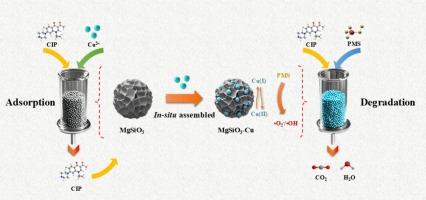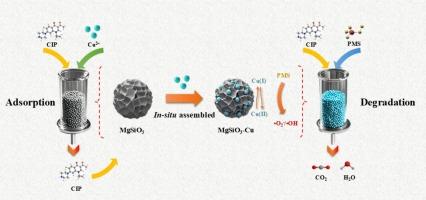Activation of peroxymonosulfate by in situ MgSiO3-Cu assembly catalyst for ciprofloxacin degradation in solution contaminated with ciprofloxacin and Cu2+
IF 4.3
2区 工程技术
Q2 ENGINEERING, CHEMICAL
引用次数: 0
Abstract
Herein, magnesium silicate particles were used as the carrier to develop an advanced oxidation technology predicated on in-situ assembled Cu-based catalysts for treating wastewater contaminated with ciprofloxacin(CIP) and Cu2+ complexes. The results show that the synthesized MgSiO3 has an amorphous structure with good cation exchange capacity for simultaneous Cu2+ removal to in situ assembly MgSiO3-Cu catalyst and ciprofloxacin degradation in the mixture wastewater. The MgSiO3-Cu/Peroxymonosulfate(PMS) Fenton-like system exhibited the highest CIP removal ability with the initial pH = 7.0, PMS dosage of 0.06 g/L, and MgSiO3-Cu dosage of 0.4 g/L, and the CIP removal rate could reach up to 98 %. The possible degradation mechanism of CIP leads to a redox cycle between Cu (I) and Cu (II), resulting in the generation of hydroxyl radicals (•OH) and superoxide anions ().


原位MgSiO3-Cu组装催化剂对环丙沙星和Cu2+污染溶液中环丙沙星降解的活化作用
本文以硅酸镁颗粒为载体,开发了基于原位组装cu基催化剂的高级氧化技术,用于处理环丙沙星(CIP)和Cu2+配合物污染的废水。结果表明,合成的MgSiO3具有良好的无定形结构,具有良好的阳离子交换能力,可同时脱除Cu2+,原位组装MgSiO3- cu催化剂并降解混合废水中的环丙沙星。当初始pH = 7.0, PMS投加量为0.06 g/L, PMS投加量为0.4 g/L时,MgSiO3-Cu/过氧单硫酸根(PMS) Fenton-like体系对CIP的去除率最高,可达98 %。CIP可能的降解机制是Cu (I)和Cu (II)之间发生氧化还原循环,生成羟基自由基(•OH)和超氧阴离子(·O2-·O2-)。
本文章由计算机程序翻译,如有差异,请以英文原文为准。
求助全文
约1分钟内获得全文
求助全文
来源期刊

Chemical Engineering Science
工程技术-工程:化工
CiteScore
7.50
自引率
8.50%
发文量
1025
审稿时长
50 days
期刊介绍:
Chemical engineering enables the transformation of natural resources and energy into useful products for society. It draws on and applies natural sciences, mathematics and economics, and has developed fundamental engineering science that underpins the discipline.
Chemical Engineering Science (CES) has been publishing papers on the fundamentals of chemical engineering since 1951. CES is the platform where the most significant advances in the discipline have ever since been published. Chemical Engineering Science has accompanied and sustained chemical engineering through its development into the vibrant and broad scientific discipline it is today.
 求助内容:
求助内容: 应助结果提醒方式:
应助结果提醒方式:


